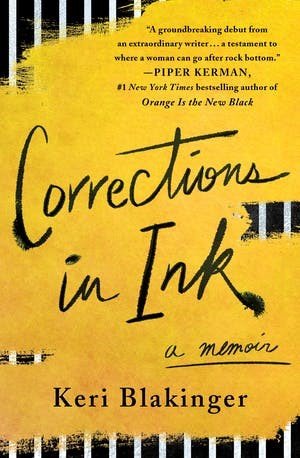Review: Corrections in Ink: A Memoir by Keri Blakinger
Reviewed by Dustin Pendley
Corrections in Ink: A Memoir is the first-person account of former figure skating star Keri Blakinger’s incarceration, a nearly two-year sentence that she spent being shipped around from one New York prison to the next. As all great prison memoirs should, this one explores the experiences and decisions that lead up to her arrest as well as detailing her life post-incarceration. Blakinger’s memoir is an important addition to the library of prison memoir, illustrating that anyone can experience addiction and, consequently, end up in a correctional facility. She further highlights the reality that American prisons are ill equipped to handle incarcerated people’s physical and mental health issues.
Rather than telling her story in a linear fashion, Blakinger’s memoir begins with the hours preceding her arrest. Weaving in and out of time between the present-day moment of incarceration and her childhood, Blakinger eventually connects these two braids more than halfway through the book. This structure is particularly effective, as it explores the thoughts that would haunt someone trying to make sense of where their life has ended up: Where did it all go wrong? How did an intelligent, athletically gifted, upper-middle-class, white, cisgender woman end up in prison? She shares stories about her eating disorder, drug use, and eventual criminal activities. As a talented, ranked Olympic hopeful, she notes the anxiety and precociousness that fueled her drive to do well, and how they were the catalyst for her self-destructive behavior and eventual incarceration.
Blakinger offers the reader a snapshot of the mindset of someone in the throes of addiction. She is concerned about school one minute and upset by emotional toll of her boyfriend’s overdose the next. Later, she shows how addiction can affect anyone, even an Ivy League student:
In our crappy apartment drug den, I mixed my lives together like a mad alchemist, decorating the walls with hand-drawn molecular diagrams of all the drugs I had for sale, the common prescriptions they might interact with, and the neurotransmitters involved. I was entranced by drug chemistry, and it became part of my sales schtick, pointing to my Sharpie-and-crayon sketches to demonstrate the difference between Adderall—pharmaceutical speed—and actual meth, and why those extra methyl groups made the drug stronger. It was as if I thought cloaking my illicit dealing in an academic veneer made it okay.
Impressively, Blakinger inserts research throughout the book, and it never feels forced or awkward, adding nuance and depth. Readers learn, for example, that the Tompkins County Jail is outdated and why architects decided to shift away from cells made of bars to cells with walls and doors. She writes, “The most visible sign of age felt theatrical, like a dark expressionist distortion of reality: the oversized clanging metal bars on the sliding gates of the front of each step.” Blakinger, a top-notch journalist who’s written for national magazines such as the Marshall Project, Houston Chronicle, and Washington Post Magazine, also uses her research skills to explore the dangerously inadequate medical care provided by prisons, among other problems. She writes about her struggles with hepatitis and how she was refused treatment because it was too much money to spend on “an inmate.” She uses this moment to expand the topic nationally, writing that incarcerated people “from Texas to Colorado to North Carolina have sued their states for refusing hepatitis treatment.”
Blakinger also focuses on the relationships built by incarcerated women, and how constant movement from one facility to the next disrupts those needed relationships that help women cope with trauma from their past. She writes, “More than half of women in prison are survivors of physical or sexual violence, and roughly three-quarters have mental health problems.” Her deft description of being “boarded out,” exposes the hypocrisy and senselessness of the process of moving inmates from one jail to another:
But worst of all, you’d have to go through medical isolation all over again—which meant being thrown in a cold, barren solitary cell for a few days or a couple of weeks. In theory that was to make sure you didn’t bring any diseases from your home jail, particularly tuberculosis. In reality we’d already been tested for TB when we got booked, so the indefinite isolation felt like nothing more than a chance to punish us just for being there. The whole process underscored the terrifying randomness of jail life: You could be minding your business, not breaking any rules—and suddenly, for no reason, have everything taken from you, be shipped away, and get thrown in a forgotten cell all alone.
Corrections in Ink is an important work and a necessary read for all of us, not just readers interested in addiction and prison memoirs. Blakinger provides an authentic experience of her addiction and subsequent incarceration for the reader, educating us about why it is important to understand and question what happens to the almost two million people serving time in our correctional facilities.
Dustin Pendley is the Coordinator of Administration for the English Department and Lead Academic Advisor for the Medical Humanities program at the University of Nebraska at Omaha. He is a mentor and advocate for formerly and currently incarcerated students, and he teaches for-credit English classes at the Omaha Correctional Center. He is excited to teach the first Inside-Out class offered by UNO at the Omaha Correctional Center next fall; Inside-Out classes bring together campus-based students and incarcerated students for a semester-long class.

